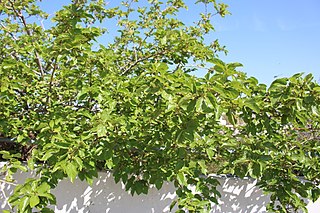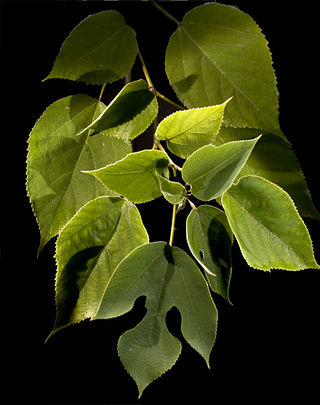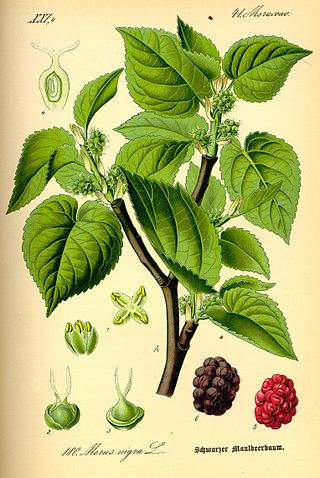
The sycamine tree is a tree mentioned in both classical Hebrew literature and in Greek literature. The tree is also known by the names sycamore fig tree, and fig-mulberry. It appears also in Luke 17:6 and 19:4 of the Bible. The Hebrew word for the tree is shiḳmah (sing.), shiḳmīn (pl.), having nearly the same phonemes in Greek Others, however, identify the tree as mulberry tree, found in two species, the Black Mulberry and the White Mulberry, which are common in Palestine. It is in the same family as the fig-tree.
The bricks are fallen, but we will build with hewn stones; the sycamores are cut down, but cedars will we put in their place.
Sycamore is a name which has been applied to several types of trees, but with somewhat similar leaf forms. The name derives from the ancient Greek σῡκόμορος (sykómoros) meaning "fig-mulberry".

Morus, a genus of flowering plants in the family Moraceae, consists of 19 species of deciduous trees commonly known as mulberries, growing wild and under cultivation in many temperate world regions. Generally, the genus has 64 subordinate taxa, three of which are well-known and are ostensibly named for the fruit color of the best-known cultivar: white, red, and black mulberry, with numerous cultivars and some taxa currently unchecked and awaiting taxonomic scrutiny. M. alba is native to South Asia, but is widely distributed across Europe, Southern Africa, South America, and North America. M. alba is also the species most preferred by the silkworm, and is regarded as an invasive species in Brazil and the United States.
Squill is a common name for several lily-like plants and may refer to:

Morus alba, known as white mulberry, common mulberry and silkworm mulberry, is a fast-growing, small to medium-sized mulberry tree which grows to 10–20 m (33–66 ft) tall. It is generally a short-lived tree with a lifespan comparable to that of humans, although there are some specimens known to be more than 250 years old. The species is native to China and India and is widely cultivated and naturalized elsewhere.
White poplar is a common name used to refer to several trees in the genus Populus, including:
Indian mulberry may refer to:

Maclura tricuspidata is a tree native to East Asia, occasionally grown for its fruit, somewhat similar to that of the related mulberry.

The paper mulberry is a species of flowering plant in the family Moraceae. It is native to Asia, where its range includes mainland China, Taiwan, Japan, Korea, Southeast Asia, Myanmar, and India. It is widely cultivated elsewhere and it grows as an introduced species in New Zealand, parts of Europe, the United States, and Africa. Other common names include tapa cloth tree.

Morus rubra, commonly known as the red mulberry, is a species of mulberry native to eastern and central North America. It is found from Ontario, Minnesota, and Vermont south to southern Florida, and west as far as southeastern South Dakota, Nebraska, Kansas, and central Texas. There have been reports of isolated populations in New Mexico, Idaho, and British Columbia.
Morus serrata, known as Himalayan mulberry, is a species of mulberry native to the Himalaya and the mountains of southwestern China, at altitudes of up to 2,300 metres.

Morus nigra, called black mulberry, is a species of flowering plant in the family Moraceae that is native to southwestern Asia, where it has been cultivated for so long that its precise natural range is unknown. The black mulberry is known for its large number of chromosomes.
M. australis may refer to:
Aecidium mori is a species of fungus in the order Pucciniales. It can only be found on flowering plants of the species Morus, the mulberries. It is found in Asia.

Morus australis, also called Korean mulberry and Chinese mulberry, is a flowering plant species found in East and Southeast Asia.

Morus indica is a species of flowering plant in the mulberry family Moraceae. As with other mulberries, it is a deciduous tree. Morus indica is native to the temperate and sub-tropical Himalayan region and is currently cultivated in India, China, Japan, and East Africa.

Morus mongolica, also described as Morus alba var. mongolica, is a woody plant native to mountain forests in Mongolia, China, Korea, and Japan. Common names include Mongolian mulberry, meng sang (China), and ilama by native people in the namesake region of Mongolia. Similar to M. notabilis, M. mongolica is an uncultivated mulberry.
This page is based on this
Wikipedia article Text is available under the
CC BY-SA 4.0 license; additional terms may apply.
Images, videos and audio are available under their respective licenses.









